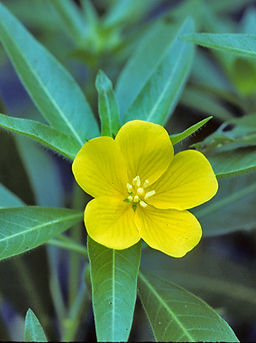

Ireland: Kerry - Dublin - Cork - Waterford - Roscommon - Galway - Belfast
UK: London - Manchester - Newcastle - Cardiff - Liverpool
Water-primrose - Invasive Species Information

What Is Water-primrose - (Ludwigia Peploides)?
Habitat: Aquatic. requires wet areas.
Distribution in Ireland: Sparse distribution.
Status: Established
Family name: Onagraceae
Common name/s: California water primrose; creeping water primrose; floating primrose; floating primrose willow; floating water primrose; marsh purslane
Reproduction: Water primrose can be generated during all seasons from small fragments of stems or rhizomes. They can be broken easily by wind, water flow or animals. The plant can also reproduce by seed.

Water-primrose flower
Water-primrose have the ability to double their biomass from their broken particles between 15 and 90 days. This also allows this species to continue to thrive in habitat and regions where sexual reproduction cannot occur.
Water primrose is a species of flowering plant in the evening primrose family known by the common names floating primrose-willow and creeping water primrose. It is native to many parts of the Americas, but it can be found on many continents and spreads easily to become naturalized.
This species is well known as a troublesome aquatic noxious weed that invades water ecosystems and can clog waterways. This is perennial herb which grows in moist to wet to flooded areas.
How To Identify Water-primrose?
Leaf: Green egg shaped or slender leaf up-to 10cm long. Arranged alternately along stems.
Flower: Five yellow petals 1 to 1.5 cm in length. Each occur on long stalks that on each leaf axils. Flowers start from the stems which are floating or lying on the ground.
Stems: Green or relish brown, fleshy, smooth or with small hairs.

Water-primrose - Ludwigia peploides ID Guide

Why Is Water-primrose A Problem?
Water primrose can form very dense (near impenetrable) mats in freshwater ecosystems. Large accumulations of this species can lead to a depletion of oxygen levels in the water while also competing with native species for space and resources.
Water-primrose Stand
The rapid and extensive development of plant populations can block waterways and thus disturb many human activities such as navigation, hunting, fishing, irrigation and drainage, reduce biodiversity and degrade water quality. have also been shown to have an alleopathic impact.
European Communities (Birds and Natural Habitats) Regulations 2011 non-native invasive plant species A-Z (Updated 2017)
There are currently 35 invasive plant species listed in the European Communities (Birds and Natural Habitats) Regulations (annex 2, Part 1)...
Click on a species from the following list to find out more regarding non-native species subject to restrictions under Regulations 49 and 50.
-
American Skunk-Cabbage - Lysichiton americanus
-
Waterweeds - Elodea (all species)
Non-Native Plant Species identified as High Risk on Ireland's Biodiversity List...
Common name
Species name
Environment
Terrestrial
Freshwater
Terrestrial
Terrestrial
Marine
Freshwater
Freshwater
Freshwater
Terrestrial
Terrestrial
Terrestrial
Terrestrial
Marine
Terrestrial
Freshwater
Freshwater
Freshwater
Terrestrial
Freshwater
Marine
Risk score
20
19
18
19
18
19
21
20
19
18
18
19
19
20
20
19
20
20
20
18